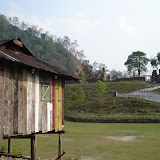History: The 51 year old, 703 foot pier and the godowns behind it are a far cry from the past when up to 50 cargo ships used to call here at a time. Opened in 1956 by the advisor to the Rajapramukh Dr. P.S. Rau, it was the only port along the South Kerala coast.
Supported by 127 concrete piles, the pier had four 3-tonne cranes and one 10-tonner to unload cargo from the ships. Since the pier was located in shallow waters, heavy ships had to anchor in the deep sea and transport their ware in smaller boats. With the development of the Kochi port with facilities for berthing of huge cargo ships, Valiathura lost its significance. It was declared a ‘dead port’ in the early eighties.
All five cranes were dismantled and sold as scrap as disuse and constant exposure to salty winds eroded their structure. The four godowns were rented out to industrial units on the Veli belt. The rails used by trolleys to transport cargo to the godowns have rusted away.
The pier which consumed 571 tonnes of cement and 250 tonnes of steel, cost about Rs.10 lakhs to build. Till today, the fishermen along the coast use the weakened structure to launch their catamarans during the rough monsoon months, when the rough sea makes the beaches inaccessible. They then jump into the sea and swim to the catamarans.
Waves here, very rarely fall below 1 m, and often exceed 4 m during the monsoon period of May to October.
There are many anglers, who occupy strategic points on the pier, holding on to their line, patiently waiting to hook a fish. Avoiding sophisticated angling gear, these people use their hands to hold the line instead of the angling rod.
The anglers here are mostly labourers and daily-wage workers.
The hooks range from 18 to 24 on a single line. There are also hooks that do not need any bait on them. But these should be regularly pulled and loosened in the water in order to attract prey. As the water current is towards the shore, the anglers need something to take the line down to the waters. For this, they use iron weights attached to the line, which provides the thrust while the line is thrown into the sea.
`Malavu', a fish that visits the coastline occasionally from inland waters, is another temptation for the anglers. `Para', `Kanava' and `Kozhiyala' are among the other visitors that swim into the trap.
A few years ago, one of the weakened piles on the right head of the 51-year-old pier developed a crack leading to the collapse of a platform measuring about 20 square feet. And in July 08, a portion of the sidewall gave in to the powerful waves lashing the structure and plunged into the sea.
In 2007, the Harbour Engineering Department announced a project for its reconstruction.
Sources
[http://www.hinduonnet.com/2007/09/05/stories/2007090553410400.htm]
[http://www.thehindu.com/2008/07/03/stories/2008070361260300.htm]
[http://www3.interscience.wiley.com/journal/119492061/abstract?CRETRY=1&SRETRY=0]
Here's a slideshow of pictures captured during my visit there in June 07. For a closer look, clickit
Wednesday, August 20, 2008
Friday, August 08, 2008
Postcard Project in AAWC
A Postcard workshop that Antoinette Maclachlan held with AAWC children, on December 28, 2007 as part of her Indian Kids Postcard Project culminated one month later, on January 29, 2008. The result - 27 hand drawn postcards of Indian Gods, Goddesses, actors and actresses.
Thursday, August 07, 2008
Buxa Duar Fort is in the eastern Dooars at a height of 867 m (2600 ft), on the Sinchula Range. It guards the Buxa Duar route, the most important of the eleven routes into Bhutan. It is believed that the Buxa Fort was constructed by the king of Bhutan during the 18th century with an intention to protect their country.
The fort was positioned so as to help guard the road connecting Tibet with India via Bhutan, which was famous known as the 'Silk Route'. The British captured this fort at the end of the 18th century and used it a watchtower.
In the 1930's as well as between 1942 to 1946, the fort was used as prison for the freedom fighters of India who was fighting against the British Empire. During this period martyrs like Jiten Gupta, Krishnapada Chakraborty, Major Satya Gupta, Trailokya Maharaj, and Hem Ghosh were kept there.
It has also served as a refugee camp for Tibetans and Bangladeshis.
Because of its historical significance the fort is considered as a place of special importance by the old timers who often visit Buxa fort to recapitulate their memories and to pay their tribute to the martyrs' column. Subash Candra Bose was kept captive at this Fort for sometime. After an exceptionally intense rain, when a landslide occurred taking most of this Fort down with it.
The deciduous forest around the fort now forms part of the Buxa National Park.
Excerpts taken from one article on East-Himalaya dot com and another from India9 dot com
 |
| Walking to the Buxa Duar Fort |
Monday, August 04, 2008
Subscribe to:
Comments (Atom)
